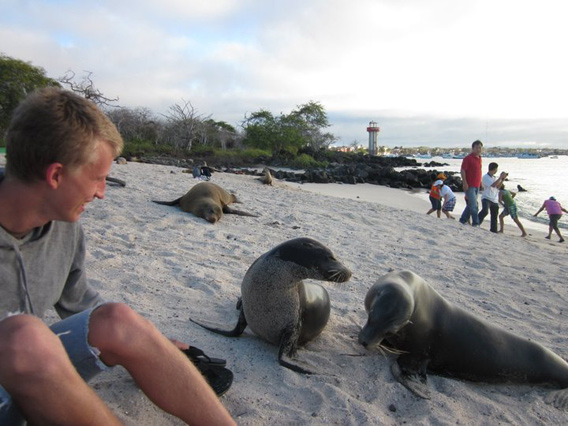
The author being approached by sealions on Playa Mann. Photo by: Rachel Lynch.
A semester abroad is an opportunity to live a sort of compacted life. In a few short months you seem to gain the experience of a much longer time and make enough memories to fill years. I recall a weeklong trip to the Alvord Desert with a field biology class from Portland Community College: the adventure of living out of a van, conducting research, and experiencing a place with classmates turned colleagues and professors turned friends who knew the desert like the backs of their hands. In that regard, it had a lot in common with my semester in Ecuador, but I can’t think of anything that could have prepared me for a four month stay in a small South American country that I knew very little about. As I write this I can’t help but marvel at how much things have changed. Ecuador has become a second home and several of its people have become close friends. I have gained a familiarity with its natural beauty that matches that of my own country and an understanding of its peril that undoubtedly surpasses it. However, much of what I have learned is about myself, and that is difficult to express. Most of these things are simply attitudes, which I couldn’t qualify or say definitively what they mean to me. Either way, after a semester of life abroad—three months of which took place on a small chain of islands—I feel as though I have returned home with something very personal that I did not have before I left. At the very least, I have learned how to better appreciate the people and places that are surrounding me at any given moment, but if I start on that now I will never get to the other, equally important, aspects of my adventure.
The Galapagos Academic Institute for the Arts & Sciences (GAIAS) offers what must be one of the most unique programs available for college students looking to go abroad. During the application process students choose between several different tracts. These include “People, Politics and the Environment”, “Marine Ecology” and “Ecology, Evolution and Conservation”. Depending on enrollment, the program coordinators hope to include at least one other tract covering geology and other ‘mountain studies’, which would stay longer in mainland Ecuador. In addition, rather than having a set of semester long courses, each GAIAS tract is made up of five intensive modules lasting three weeks: the dream of short attention-spanned students worldwide. The practical benefit of this is that each of the often multifaceted subjects can be explored single-mindedly and in-depth. Furthermore, as each course is highly based on travel and field experiences, this allows each professor to move their class around at will.
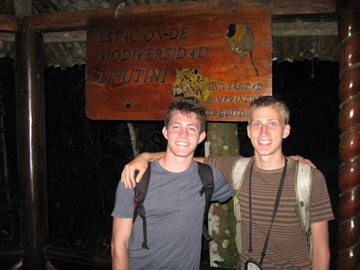 Michael Rudolph (right) in Tiputini Biodiversity Station. Rudolph is 19. He is majoring in English and minoring in Biology at Southern Oregon University. |
Upon arrival in Quito we were all picked up by our first host families, and after months of forms and visa work the idea that we were going to be living in another country started to feel real. It was night when my host-dad Washo drove me home from the airport, and though the city had looked like a vast sea of lights from the air I could see nothing beyond the freeway we were driving on. My Spanish was pitiful, but luckily Washo spoke good English, and we talked about the city and how Ecuadorians felt about using American currency, which they switched to in 2000. At the end of the drive we pulled into a gated community and my host-mom Gabby, and Trevor, another student from Oregon staying there, came out to greet us. Placed together for playing guitar and both being vegetarians, Trevor and I quickly became good friends. In the morning we woke up early for orientation and for the first time saw the valley and its high mountainous walls by daylight from our host family’s patio, including the winding road leading downhill through Cumbaya to La Universidad San Francisco de Quito, the campus where we would have our first module. Each day that we bussed down that hill to class and back, we noticed a new white-capped volcano somewhere on the horizon through a break in the near-perpetual clouds.
It was impossible to hide our excitement as we walked onto campus for the first time and saw our group, which we had only briefly met in the airport the night before. The stand-out feature of our orientation that day was a security briefing by a machismo representative from the US Embassy, who successfully scared the crap out of us with stories of Quito’s crime and danger: we were never to use a cab that did not have an orange license plate or identification number for fear of being kidnapped, never to take a pamphlet or brochure from anyone on the street because the paper could be laced with scopolamine, never to eat street food, always to travel in groups, never to go in a city park, and never to resist if we found ourselves being mugged at knife or gun point. Also, there was a fifty-fifty chance that some sort of political upheaval would occur during our stay. At the end of the month, partly I’m sure due to the caution that obnoxious briefing had instilled, nothing unfortunate had happened to any of us.
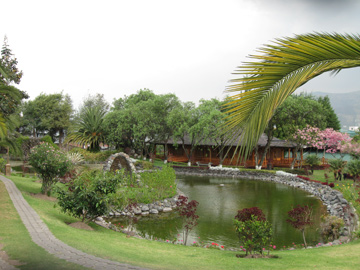 The campus of San Francisco University in Quito. Photo by: Michael Rudolph. |
That first module for “Evolution, Ecology and Conservation” in Quito was unlike any class I had ever taken. The workings of the diverse ecosystems of Ecuador were seamlessly woven together with the philosophy, and complications, of their conservation. I soon discovered that my professor, Esteban Suarez, and the politics professor, David Romo, were deeply involved in the issues that we were discussing in class. While the Marine Ecology group headed to the coast for a ten day field trip and SCUBA certification, the Evolution group stayed three nights at Maquipucuna, a reserve of cloud forest successfully recovering from deforestation fifty years ago. Here we set the pattern for our impending week long stay in the Amazon: hiking all day, learning about everything from soil conditions to epiphyte growth. We ate meals at the research station and bunked four to a room, enveloped in the cacophony of insects and frogs outside. One evening, after the sun had gone down and we turned on the porch lights to give presentations, we found ourselves surrounded by a steadily growing cloud of moths and other insects drawn to the light, some of them so enormous that they dwarfed the hummingbirds that had frequented the station’s feeders by daylight. The scene climaxed with the arrival of a black beetle, bigger than a mouse, which attached itself to my pant-leg during my presentation and sent me dancing off in panic and inadvertently stepping on it as it fell off (which hurt my foot but left the behemoth unharmed). After a minute of recuperation it crawled away looking only a little confused.
Looking back, it was wise of our coordinators to take us to a recovered forest early on in our semester. We had seen the Paramo, under threat from burning and grazing in the Andean highlands, but nothing could match the emotional impact of our trip to Yasuni National Park, arguably the most biologically diverse region on the planet. To get to our home in Yasuni, the Tiputini Biodiversity Station, we first flew from Quito to the oil-boom town of Coca where we boarded a boat down the Napo River. After about an hour of watching the forested riverbank through the mist, the small, persistent flame of an oil tower came into view. Before our departure we had watched the documentary “Trinkets and Beads,” about the grim history of oil exploitation in the area, which had us all groaning over the fact that we had taken planes to come to Ecuador. I think I speak for most of my class when I say that with the sighting of the oil tower I began to feel helpless in the face of the environmental issues in which I was immersing myself. The next stage of our journey began at the security checkpoint at the beginning of the infamous Maxus Road, which we had already learned about in class and from the documentary. Soon we were passing roadside pipeline construction sites cut out of the rainforest and being waved at by indigenous workers whose recent ancestors had killed to prevent this very situation from becoming a reality. Photography was not allowed.
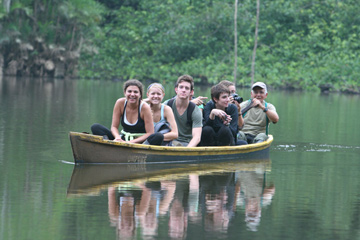 GAIAS students in Yasuni National Park. Photo by: Jeremy Hance. |
As painful as many of the things we saw were, we knew that our professors’ connection to them far surpassed our own: this was their country and the issues we now faced had been the focus of their lives for many years. They were not naïve optimists or fatalistic pessimists, they were realists and activists and if they hadn’t given up yet we couldn’t either. The most important thing that I took away from that first module was the ability to think about the world’s environmental problems in a way that would not make me go crazy, or want to run away, something that proved vitally important for the next three months on the Galapagos Islands.
I knew that remaining a vegetarian while in the Galapagos was going to be difficult, and a few weeks in (after many half-failures explaining my diet to the restaurants providing our meals, and not wanting to refuse food from my host-family) I started eating fish. It felt a little like jumping off a cliff the first time, but I quickly stopped thinking about it. The problem came when our class joined the Marine group for a course on marine ecology. We had just finished our first Galapagos module on evolution, and had stayed pretty clear of issues of conservation, but the marine class was fresh out of a course on fish identification and habitat. They were now able to point at the fish on our plates at lunch and tell us whether or not it was endangered, or legal to harvest inside the marine reserve. To make matters worse, two of my classmates began volunteer monitoring for the National Park and every day while monitoring at Tijeretas, a popular snorkeling spot, they observed boats entering the bay against park regulations to clean their catch or go spear-fishing.
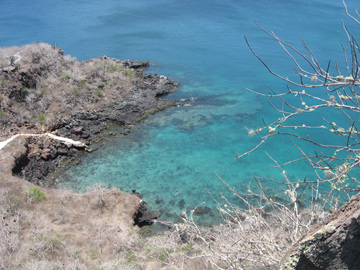 Tijeretas Bay. Photo by: Edgar Javier. |
In the Marine Ecology class we learned about the value and sensitivity of the Galapagos Marine Reserve and Ecuador’s financial inability to enforce the laws protecting it, not only from small violations like the ones described above, but also from illegal commercial fishing by foreign fleets in open water. It hit me that I could not justify coming to such a unique place to study its conservation and yet consume its natural resources. I reorganized my meal plan to stop eating fish, but continued to find myself in situations where I felt I had no choice: frustration was mounting for many of us.
Diet proved to be only the beginning of a long string of contradictions I felt myself participating in while in the Galapagos Islands. Despite a curriculum that was meant to address the many aspects of their management, including the care of the people who live there, it was becoming clear that human interests and conservation goals were fundamentally at odds. The amount of people the Galapagos Islands could naturally support is very small and yet the population, and the amount of tourists that flock to Galapagos yearly, continues to increase. I felt painfully aware that I was a part of that number. Without the costly shipment of food, building materials and even fresh water from mainland Ecuador human life on Galapagos would not be possible and its two hundred year conflict between man and nature would not exist.
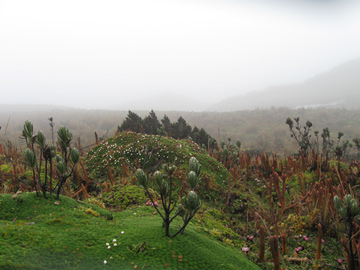 Otherwordly plants of the Paramo in the highlands of mainland Ecuador. Photo by: Michael Rudolph. |
Throughout our three months on the islands many national park-led tourist activities were booked for us. Though there is rarely another way to see some of the Galapagos’ most beautiful and interesting locations the tours often had a bittersweet edge. On the mainland our excursions had been led by our professors (some of the most knowledgeable and invested people I have ever met), but after weeks of studying the ecology and evolutionary history of the Galapagos we found ourselves stuck listening to tour guides that were only just as knowledgeable, or less knowledgeable, than we were, and because we rarely heard anything we hadn’t covered in class (and occasionally information that did not seem as credible as what we had heard in class) we lacked the enthusiasm that was expected of us. Both the GAIAS students and our tour guides often left unsatisfied by the interaction.
After so many lackluster tourist outings, and suffering from guilt for participating in the degradation of the islands as a visitor, I began to wonder what to tell friends and family back home if I was asked whether or not I recommended that they travel to the Galapagos. To say blatantly that I did not think they should, would give the impression that I did not enjoy my time there, or that I was not grateful for my opportunity, when neither of these things were true. The reality is that my experience was made by the people, both in my class and out, that I got to know and spend time with; by the classes I took and the professors who taught them; and by becoming a part of one of the most unique and interesting communities that I know of. When I think about a typical touristic experience of the place where I was able to live for three months I feel that the reality of the islands—their beauty, their peril, their people and the complexity of that interaction—would all be missed.
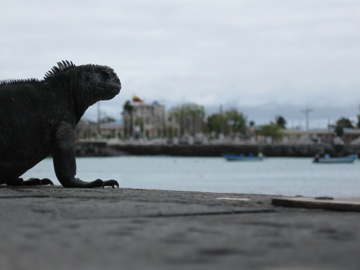 Marine iguana. Photo by: Michael Rudolph. |
I remember one morning on Santa Cruz when the class walked out to Tortuga Bay. The first things we noticed on the expanse of white sand beach in front of us were the black and red-mottled iguanas, heading towards the refuge of volcanic rock at the far side like the fabled prehistoric march of the last starving dinosaurs. Louise, the Marine Ecology professor, sat us down for a talk about the Master’s Thesis he had done there about the influence of El Niño on the algae blooms that the iguanas depend on. We were used to long talks, but the last person had barely sat down when he mentioned something about marine iguana gene flow between islands and then finished, suddenly releasing us to enjoy the bay.
We walked through the mangroves behind us, side-stepping iguanas and skirting the stands of trees, feeling the soft sand beneath our feet. We came out in front of a sheltered lagoon scattered with Santa Cruz’s earliest risers. Most of us were taking off our shirts and spitting in our masks to go snorkeling. A minute later we were chest deep in the murky water, going out in search of white-tip sharks. We continued fanning out as the water deepened to a point we couldn’t walk and simultaneously grew clearer and colder. My classmates started raising their heads, sputtering their sightings so that the rest of us could come and see: an eagle ray, four cow nose rays, puffer fish, then marble and diamond rays—all were added to the list. The cow nose rays I saw that day were like a vision of angels: brown like caramel with white undersides, cat-sized, soaring together like birds in slow motion, long smooth tails trailing behind them like those of kites. It was one of the most beautiful things I have ever seen.
Ahead of us were two outcroppings of black lava rock, and collectively we made our way towards them. The water got shallow again, to the point that it was barely sufficient to keep my belly off the weedy bottom. I kept my lungs as full as possible; entertained by the challenge. I was watching tiny trumpet shaped “half-beaks” wiggle their tails, combing the meniscus of the water’s surface for food when I heard some muffled screams from about twenty feet away. I raised my head and saw that my classmates there had suddenly stood up and were calling me over excitedly. I hurried towards them, unable to see more than eight feet in front of me as I cruised through the few inches of water with my flippers, arms dangling behind me, useless because of the closeness of the bottom. Then suddenly, at the edge of my sight, mud swirling around it, I saw the spotted wings of an enormous eagle ray undulating to recoil from me. Like me, the sheer girth of its body occupied the whole space between the water’s surface and the bottom and there wasn’t much for either of us to do. Having first bolted from my friends, and now almost having run into me, the ray now bolted off in the only direction it could. I swore into my snorkel and turned around as fast as I could before my surprise wore off. Then everyone went off to follow it.
Later we found a group of white-tip sharks which avoided us like the plague and scattered. After that we kept it to ourselves when we had one near us so that we could follow it as long as possible without the group coming and spooking it. But by then we were cold and tired and a few of us swam over to the lagoon’s rocky edge to bask with the iguanas until we were dry and warm enough to swim back. As I closed my eyes a remorsefulness crept into me, that to see these beautiful creatures I had essentially terrorized them; a paradox not at all different from the fact that by visiting and living on these beautiful islands I was contributing to their destruction.
Despite the contradictions involved in coming to the Galapagos, I applaud this program for providing us with the attitudinal tools to want to make a positive difference there. GAIAS may not be perfect, but it is the first of its kind and is getting better every year. However, it can only be as influential as its students. It is our responsibility to decide how to use what we gained through our experience. While there many of us formed connections that will direct the next stage of our lives. Some are hoping to return to work on vital research with our professors or work in the new labs being built on campus. Others are hoping to see conservation projects through to completion that were begun in class or have already begun on social projects and community education that could help mitigate the effect of human presence in the Galapagos. I hope that writing will be my way of giving back.
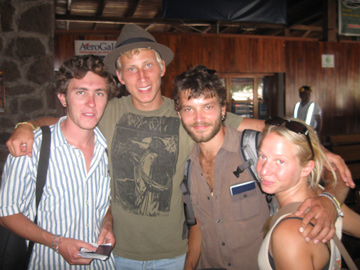 Leaving Ecuador, Michael is second from the right. Photo courtesy of: Michael Rudolph. |
The cruel thing about a semester abroad is that despite initial and even late waves of homesickness, four months seems to be about how long it takes to start to feel at home in a place. And in our case, four months of compacted adventures with a relatively small group was more than enough time to start to feel like family. I can find no comparison for the strange feeling of that time coming to an end, especially after months of missing the friends and family that I was finally returning to.
From the beginning we knew that our experience in Ecuador was temporary, but the end felt very far away. No matter how long some weeks seemed, aching for home, or how short; living life to the fullest and wishing it would never end, time steadily passed. I imagined that the most surreal part of the whole thing would be the plane home: suddenly separated from the people I had grown so close to, but not yet reunited with the people I’d missed so badly. It was to be a time for decompression, for a very necessary meditation on how appreciative I was for having had this experience, and a preparation for the uncertainty of what home would feel like. Sore from travel and sleep deprived, when my mother picked me up from the Portland airport I was surprised to find that it didn’t feel like anything at all. Except for the exhaustion we may as well have been driving home from the grocery store. I could already feel my memories fading and becoming dreamlike. That night I went to sleep in my old bed for the first time, knowing that in the morning I would be waking to my first full day of Oregon winter. I had warned the people waiting for me that I might be a little shell shocked, but I survived. Now the real challenge has begun: the processing of my experience, including all that I have learned, and the slow trial-and-error integration of my experience in Ecuador into the rest of my life.
To read more of Michael Rudolph’s adventures see his travel blog.
Related articles
Undergrads in the Amazon: American students witness beauty and crisis in Yasuni National Park, Ecuador
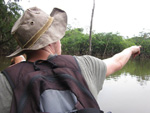 (10/28/2010) Although most Americans have likely seen photos and videos of the world’s largest rainforest, the Amazon, they will probably never see it face-to-face. For many, the Amazon seems incredibly remote: it is a dim, mysterious place, a jungle surfeit in adventure and beauty—but not a place to take a family vacation or spend a honeymoon. This means that the destruction of the Amazon, like the rainforest itself, also appears distant when seen from Oregon or North Carolina or Pennsylvania. Oil spills in Ecuador, cattle ranching in Brazil, hydroelectric dams in Peru: these issues are low, if not non-existent, for most Americans. But a visit to the Amazon changes all that. This was recently confirmed to me when I traveled with American college students during a trip to far-flung Yasuni National Park in Ecuador. As a part of a study abroad program with the University of San Francisco in Quito and the Galapagos Academic Institute for the Arts and Sciences (GAIAS), these students spend a semester studying ecology and environmental issues in Ecuador, including a first-time visit to the Amazon rainforest at Tiputini Biodiversity Station in Yasuni—and our trips just happened to overlap.
(10/28/2010) Although most Americans have likely seen photos and videos of the world’s largest rainforest, the Amazon, they will probably never see it face-to-face. For many, the Amazon seems incredibly remote: it is a dim, mysterious place, a jungle surfeit in adventure and beauty—but not a place to take a family vacation or spend a honeymoon. This means that the destruction of the Amazon, like the rainforest itself, also appears distant when seen from Oregon or North Carolina or Pennsylvania. Oil spills in Ecuador, cattle ranching in Brazil, hydroelectric dams in Peru: these issues are low, if not non-existent, for most Americans. But a visit to the Amazon changes all that. This was recently confirmed to me when I traveled with American college students during a trip to far-flung Yasuni National Park in Ecuador. As a part of a study abroad program with the University of San Francisco in Quito and the Galapagos Academic Institute for the Arts and Sciences (GAIAS), these students spend a semester studying ecology and environmental issues in Ecuador, including a first-time visit to the Amazon rainforest at Tiputini Biodiversity Station in Yasuni—and our trips just happened to overlap.
Oil, indigenous people, and Ecuador’s big idea
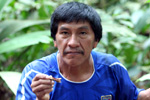 (11/23/2010) Ecuador’s big idea—potentially Earth-rattling—goes something like this: the international community pays the small South American nation not to drill for nearly a billion barrels of oil in a massive block of Yasuni National Park. While Ecuador receives hundred of millions in an UN-backed fund, what does the international community receive? Arguably the world’s most biodiverse rainforest is saved from oil extraction, two indigenous tribes’ requests to be left uncontacted are respected, and some 400 million metric tons of CO2 is not emitted from burning the oil. In other words, the international community is being asked to put money where its mouth is on climate change, indigenous rights, and biodiversity loss. David Romo Vallejo, professor at the University of San Francisco Quito and co-director of Tiputini research station in Yasuni, recently told mongabay.com in an interview that this is “the best proposal so far made to ensure the protection of this incredible site.”
(11/23/2010) Ecuador’s big idea—potentially Earth-rattling—goes something like this: the international community pays the small South American nation not to drill for nearly a billion barrels of oil in a massive block of Yasuni National Park. While Ecuador receives hundred of millions in an UN-backed fund, what does the international community receive? Arguably the world’s most biodiverse rainforest is saved from oil extraction, two indigenous tribes’ requests to be left uncontacted are respected, and some 400 million metric tons of CO2 is not emitted from burning the oil. In other words, the international community is being asked to put money where its mouth is on climate change, indigenous rights, and biodiversity loss. David Romo Vallejo, professor at the University of San Francisco Quito and co-director of Tiputini research station in Yasuni, recently told mongabay.com in an interview that this is “the best proposal so far made to ensure the protection of this incredible site.”
A look at Ecuador’s agreement to leave 846 million barrels of oil in the ground
(09/13/2010) Ecuador’s pioneering initiative to voluntarily leave nearly a billion barrels of oil under Yasuní National Park, an Amazonian reserve that is arguably the most biodiverse spot on Earth, took a major step forward in early August when the government signed an accord with the United Nations Development Programme (UNDP) for the long-awaited establishment of a trust fund. The signing event generated a wave of international media attention, but there has been very little scrutiny of what was actually signed. Here we present an initial analysis of the signed agreement, along with a brief discussion of some of the potential caveats. Due to the precedent-setting nature of this agreement, attention to the details is now of the utmost importance.
Photos: park in Ecuador likely contains world’s highest biodiversity, but threatened by oil

(01/19/2010) In the midst of a seesaw political battle to save Yasuni National Park from oil developers, scientists have announced that this park in Ecuador houses more species than anywhere else in South America—and maybe the world. “Yasuní is at the center of a small zone where South America’s amphibians, birds, mammals, and vascular plants all reach maximum diversity,” Dr. Clinton Jenkins of the University of Maryland said in a press release. “We dubbed this area the ‘quadruple richness center.'”
Extinctions on the rise in the Galapagos: fishing and global warming devastating islands’ species

(12/03/2009) We may never see again the Galapagos black-spotted damselfish, the beautiful 24-rayed sunstar, or the Galapagos stringweed. These species from Galapagos waters may all very well be extinct. Other species are on the brink, such as the Galapagos penguin and the Floreana cup coral. A new report in Global Change Biology reveals that in just a matter of decades, overfishing and climate change has devastated the Galapagos’ unique and famous ecosystems.
World’s smallest orchid discovered in Ecuador
(11/30/2009) Measuring just 2.1 millimeters wide, the world’s smallest orchid has been discovered hiding in the roots of another plant, reports the Independent.
Oil road transforms indigenous nomadic hunters into commercial poachers in the Ecuadorian Amazon
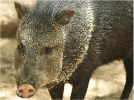
(09/13/2009) The documentary Crude opened this weekend in New York, while the film shows the direct impact of the oil industry on indigenous groups a new study proves that the presence of oil companies can have subtler, but still major impacts, on indigenous groups and the ecosystems in which they live. In Ecuador’s Yasuni National Park—comprising 982,000 hectares of what the researchers call “one of the most species diverse forests in the world”—the presence of an oil company has disrupted the lives of the Waorani and the Kichwa peoples, and the rich abundance of wildlife living within the forest.